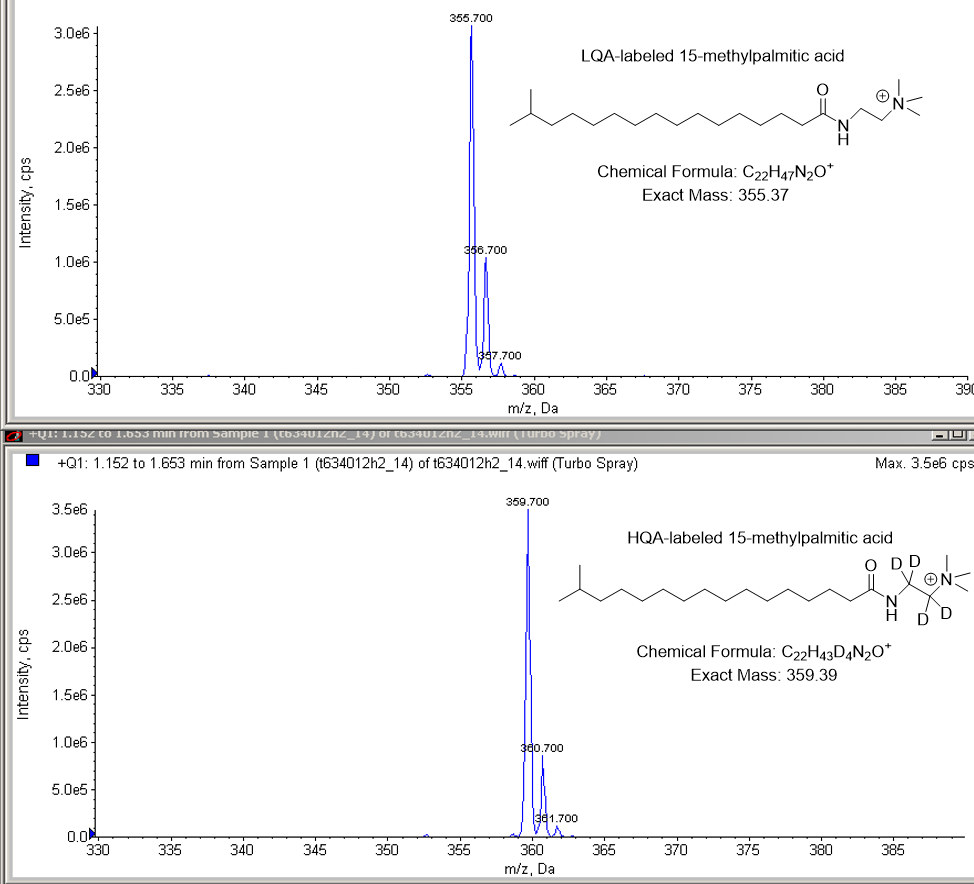Product Description
| Download Documents | |
| SDS | USER MANUAL |
Carboxylic acid-containing molecules, including fatty acids and prostaglandins, play key roles in metabolic pathways. Detection and quantitation of such molecules by mass spectrometry after derivatization with quaternary amine containing signal-enhancing molecules is well documented in the literature (Torde et al. 2013 Multiplexed Analysis of Cage and Cage Free Chicken Egg Fatty Acids Using Stable Isotope Labeling and Mass Spectrometry. Molecules, 18(12), 14977–14988).
CellMosaic® designed this kit for simple one-step quaternary amine (MS-Tags) labeling of carboxylic acids, including fatty acids and prostaglandins, for enhanced detection by positive ion mode mass spectrometric analysis. After 10-minute ambient temperature derivatization, the reaction can be analyzed directly by LC-MS techniques. The kit contains reagents for a total of 50 labeling reactions for Light Quaternary Amine (LQA) and Heavy Quaternary Amine (HQA).
Key Features of this MS Labeling Kit
- Simple protocol with less than 15 min total hands-on and reaction time.
- Stable linkage
- Single conjugation step, fast and easy preparation: 4 h preparation and <30 minutes hands-on time
- Quantitative labeling of the acid.
- Over 90% pure conjugated products by SEC
- HQA-labeled analyte’ can be used as an internal standard when heavy atom-labeled analyte is not commercially available.
- Separately, LQA and HQA can be used to label different samples. After quenching the reaction with water, the reactions can be mixed and analyzed in a single LC-MS run to increase the throughput.
- In MS/MS mode, after neutral loss of trimethyl amine (Me3N), the product ion will retain the heavy atoms, enabling different non-interfering parent and product ion monitoring for LQA-Analyte and HQA-Analyte in LC-MS analysis.
Labeling Chemistry

Typical Kit Performance Data (CellMosaic®)
Labeling Efficiency Quantitation
Labeling efficiency is assessed using Fmoc-Cys(Trt)-OH and quantitated by UV/HPLC analysis. Figure 1 shows a typical HPLC profile of Fmoc-Cys(Trt)-OH and LQA-labeled product. Table 1 shows the labeling efficiency for various amounts of carboxylic acid. The labeling is almost quantitative for < 200 nmol.
Figure 1: A typical C4-HPLC profile of Fmoc-Cys(Trt)-OH (Red, 5 nmol) and LQA-labeled product (blue, 0.25 nmol)

Table 1: Labeling efficiency of Fmoc-Cys(Trt)-OH (quantitation by C4 HPLC at 280 nm) following the standard protocol.
|
|
Fmoc-Cys(Trt)-OH (nmol) |
Labeling efficiency |
|
LQA (240 nmol) |
2.5 |
>99% |
|
50 |
>99% |
|
|
200 |
>70% |
|
|
HQA (240 nmol) |
2.5 |
>99% |
|
50 |
>90% |
|
|
200 |
>80% |
MS Analysis of Fatty Acids After Labeling (CellMosaic®)
Example 1: MS analysis of LQA- and HQA-labeled heneiocosanoic acid

Example 2: MS analysis of LQA- and HQA-labeled 15-methylpalmitic acid

Frequently Asked Questions:
If you can’t find the answer you’re looking for or need information on general topics, please visit the main Frequently Asked Questions (FAQs) section.











